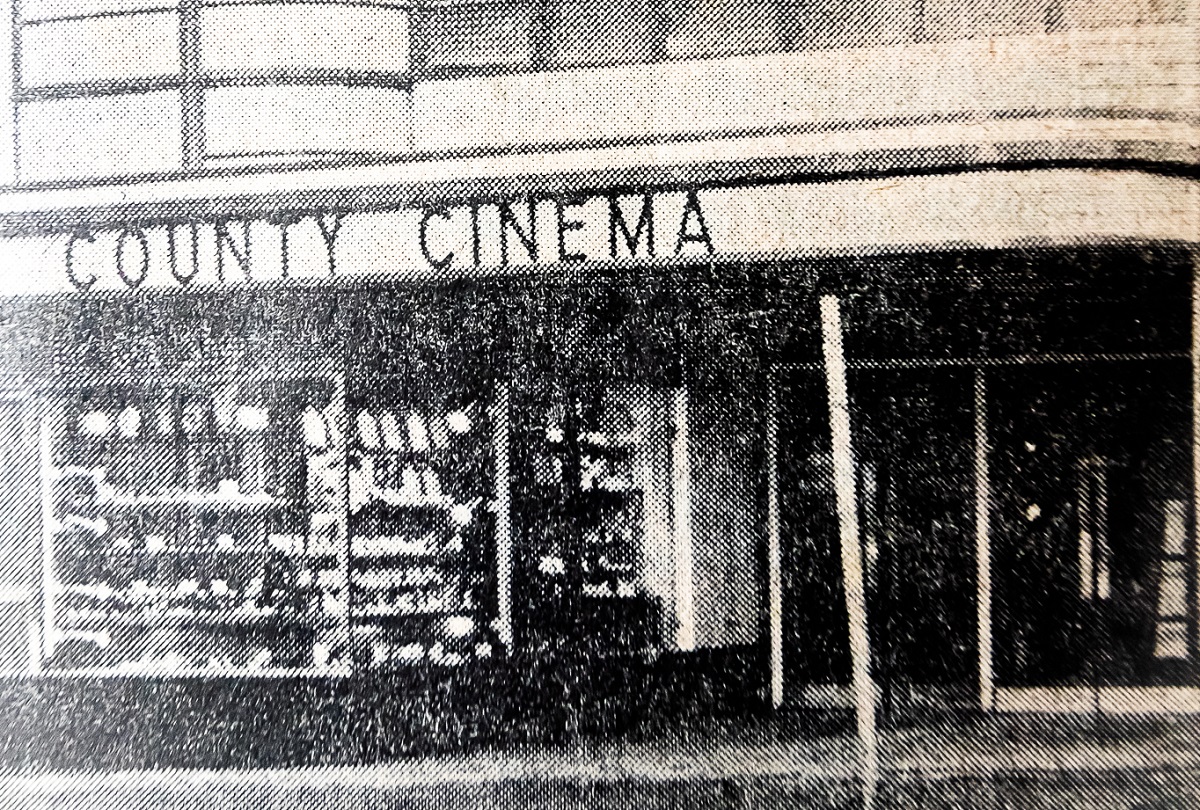Omagh once boasted a vibrant cinematic culture that gave locals the choice of three different ‘picture houses’ to visit in the town.
The first of these was established on Sedan Avenue in 1926 by a man named Charles H Donaghy.
He created a small one-screen outlet called ‘Star Kinema’, which could hold around 450 people.
The ‘Kinema’ actually had a dramatic storyline of its own when it was badly damaged by a fire in 1940.
However, it reopened after repairs and continued operating until 1947.
Another cinema was located behind the Royal Arms’ ballroom, and was named ‘The Picture House’.
It could hold 600 people, and was also run by Charles Donaghy, who didn’t seem to have much luck with his premises.
This cinema became damaged in 1946 due to flooding from heavy rain, but it remained open until 1961.
However, probably the grandest of all those early cinemas was the ‘County Cinema’, located where SuperValu is now.

It opened on January 13, 1940, with just one screen, but boasted the capacity to hold 850 people. Again, Charles H Donaghy was behind the venture, along with Charles C Patterson.
This glamorous Hollywood-style ‘blockbuster cinema’ featured a long, narrow entrance which led to the vast auditorium.
Within, there was a 38ft wide arched stage, covered by a curtain and patrons sat on lounge chairs and furniture fitted by local man, J B Anderson.
In terms of sound, the stage was fitted with a state-of-the-art (for its time) RCA sound-system, which consisted of microphones for the stage, and speakers to project the sound.
However, Charles H Donaghy was tasked with the tiresome activity of hand-cranking the projector to play the film. Thankfully, films back then weren’t as long as the three-hour feature lengths we see today, but yet, the task of consistently cranking the film through at 25 frames a second was not only physically-demanding, but also mentally-draining.
A special screening for selected guests to mark the official opening of the new County Cinema showed the 1935 film, ‘Cardinal Richelieu’.
The film was based on a play from 1839 about French statesman Cardinal Richelieu, portrayed by George Arlis, and his conflict with King Louis XIII, played by Edward Arnold.
When the cinema opened its doors to the public, it hosted ‘The Four Feathers’ starring Ralph Richardson.
Shortly afterwards, a drunken soldier decided to break in one summer’s night and rob one of the owners.
On June 4 of 1940, it was reported that a sum of money had been stolen from Mr Patterson’s office. An investigation ensued, and before the Azzies court on July 24 stood a soldier from St Lucia Barracks, charged with the theft.
The Fusilier pled guilty to the charge, and admitted that it was his first time drinking alcohol when he decided to break in and steal a small amount of money from the office.
It is recorded that the soldier cost £6 in damages – the equivalent of more than £400 in today’s money.
In the 1950s, the cinema broadened its remit slightly by also hosting live theatrical performances.
This decision saw celebrity performers, such as comedian, Frank Carson, and pop singer, Billy Fury, take to the stage in the county town, much to the delight of local fans.
For years, the cinema continued to entertain local audiences with screenings and stage plays.
In 1964, it actually became the first cinema in Ireland to acquire the latest feat of advanced cinematic technology – much to the relief of the operator.
This innovation spared operators the physical strain of hand-cranking, ensuring seamless film projection at 25 frames-per-second.
However, the new equipment would not see ten years of service, as the end of the County Cinema was nigh.
As the Troubles unfolded in the North, Omagh’s cinematic landscape began to change.
Decreased attendance, barricades in the town centre, and the rise of televisions marked the decline of the once-thriving culture.
Proprietor at the time, Noel J Donaghy, lamented the varying factors which made him decide to close.
“One of the reasons was the low attendances at some of the shows since the summer months, when the barricades were erected in the town.
“People coming to the cinema liked to park their cars near the cinema, but since the barricades went up, they are not able to bring their cars in.
“Housewives, some of whom were our best customers, also stopped coming due to the Troubles, and, in fact, it was the same with many of our other patrons. Other pastimes like bingo and the changing trend in pub entertainment have altered the direction of support in social recreation,” he stated in an interview with the UH..
Noel also fondly reflected on the peak years of the County Cinema.
“I remember in those days the cinema was packed every day of the week; there would not be a seat left,” he said.
“That was one of the reasons why we used to have ‘two houses’; when we would get a crowd in at the first showing, and then later in the night when we showed the picture again, we would have the cinema packed.
Although, many who came for the first house would stay all evening.
“Business in those days was exceptionally good, because after everybody had paid for their seat… countless ice-creams, chocolates and apples would be bought.
“It’s isn’t like that nowadays at all.”
So, in 1973 the County Cinema closed for good. Its last film?
‘The Andromeda Strain’ with James Olson.







